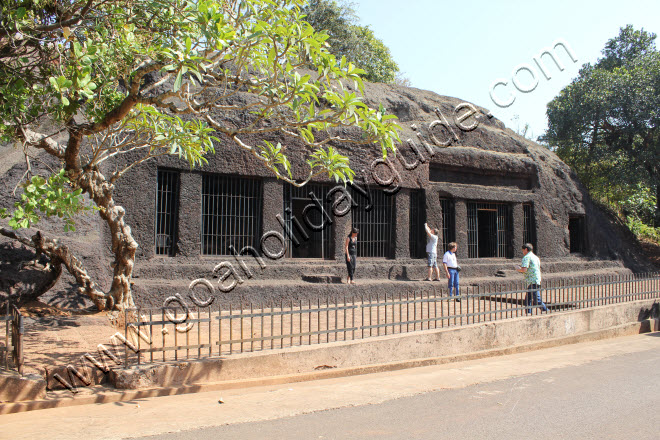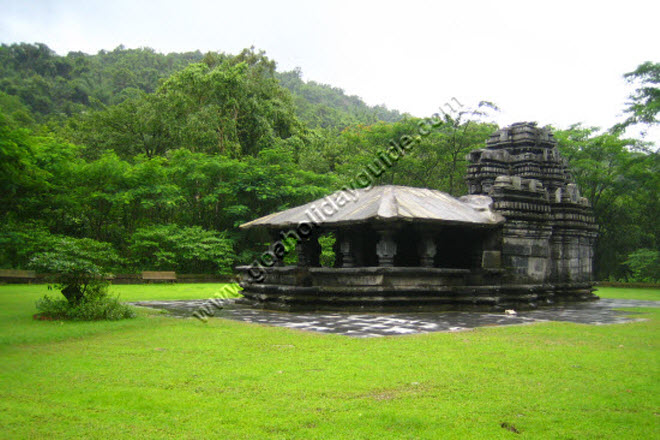Bronze And Iron Age In Goa
Arvalem Caves
The Arvalem Caves known as the Pandava Caves, got their name from the five Pandavas of Mahabharata who as per myth, sought refuge in these during their exile.The presence of five compartments and Shiva lingas in the caves support this fact.
Mahadev Temple
The Mahadev Temple is a small, exquisite 12th century Shiva temple of the lord Mahadeva, located 13 km east of Bolcornem village. The temple consists of garbhagriha, antarala and a pillared Nandi mandapa built of basalt. The four pillars, embellished with intricate carvings of elephants and chains support a stone ceiling decorated with finely carved lotus flowers of the Ashtoken variety.
The Advent Of Buddhism
Vestiges of Buddhism of the Hinayana sect, belonging to the pre Christian era have been found at Rivona, Lamgaon, Harvalem and near Priol. According to the Buddhist text of Amavatur and Saddarmaratnakare composed in a later period, the Buddhist monk, Purna or Punn, was originally a resident of Sunapurant, identified with the present Goan region from the village of Zambaulim. Purna was received into the Buddhist fold by the Buddha himself and helped spread that faith in this region and further south up to Sri Lanka of today.
Purna is reported to have transformed the Goan people, once violent and rancorous, into a peaceful and benevolent community. A stone statue of the Buddha in the meditation pose was discovered in Colvale village in Bardez in Northern Goa. It is believed to belong to the 2nd century AD, apparently influenced by Greek art.
It may be noted that the Buddhist monk Dharmarakshita, deputed by the emperor Asoka to the Rashtrakutas and the Bhojas from the Konkan, was a Greek convert to Buddhism. Traces of Buddhism and Jainism too have been found in Chandor, about 66 kms. from Panaji in Salcete. The Kadamba kings who ruled from Gopakapattam for a couple of centuries had wholeheartedly adopted the religion, to an extent of discriminating against their earlier Hindu coreligionists before returning to their original fold.
The oldest brick temple in Goa and probably in the whole of southern India was unearthed here, built on the ruins of an earlier brick structure. At the Brahmavtara in Mapusa, in northern Goa at the Shantadurga temple site was found on excavation a cup like object in red earthen ware. Its was found having some resemblance to Roman cups that have been found in excavations in Karhad and Kolhapur in neighboring Maharashtra. The temple of Sri Mahamaya at Nundem in Sanguem, also belongs to their period. Its construction is placed at 5th century A.D. as seen from the Brahmi characters on a stone inscription on it. The Arvalem caves also belong to this period. They are popularly known as Pandavancheo Honvreo (Pandava Caves).
A large number of sati stones in different designs and veergallas or hero stones depicting naval battles, war scenes wherein cavalry and war elephants were used have been depicted have been found in many places in Goa. Similarly a large number of sculptures of the lion which is considered the vehicle of the goddess durga, was adopted as the royal emblem by the Kadambas in Goa, have been found particularly around Chandor, and Goa Velha which were their ancient capitals.
The Indo-Aryan Migrations To Goa
The first wave of Indo-Aryans came and settled in Goa about 2400 B.C. Some of them might have been followers of Vedic religion. They were known to speak earliest form of Prakrit or Vedic Sanskrit vernacular. This migration of the northerners is mainly attributed to the drying up of the mighty Sarasvati River. Almost of Historians claim only Gowda Saraswat Brahmins and few of the other Brahmins to be their descendants. This hypothesis is not true according to some. Balakrishna Dattaram Kamat Satoskar, a renowned Goan Indologist and historian, in his work Gomantak Prakruti ani Sanskruti, Volume I, explains this. Balakrishna explains that the original Sarasvat tribe consisted of people of all the folds who followed the Vedic four fold system and not just Brahmins. He explains that the caste system was not fully developed then, and did not play an important role in society.
Some historians also propose a theory of migration of the Bhargava tribe to Goa, from Gujarat. This tribe was called so because of their clan symbol which was an axe. This theory links the Parashurama myth with the history. According to this theory the Bhargava clan is connected to the mighty Phrygians in Asia Minor, and Parashurama also known as Bhargavarama was one of their clan leader. These Bhargavas might have started their sea-expedition before the Mahabharata war. Angiras tribe is also believed to have migrated from the North-western India during this time.
The second wave of Indo-Aryans occurred sometime between 1700 B.C. and 1400 B.C. This second wave migration was accompanied by Dravidians from the Deccan plateau. A wave of Kusha or Harappan people a Lothal probably around 1600 BC to escape submergence of their civilization which thrived on sea-trade. With the admixture of several cultures, customs, religions, dialects and beliefs, led to revolutionary change in the formation of early Goan society.
The Advent Of Sumerians
In 2200 B.C., the first written reference to Goa appears to have been in Cuneiform, in Sumerian times when the King Judea of Lagash called it Gubio. The Sumerians had established trade contacts with Goa. Many Sumerians settled in Goa and along the Konkan coast. Sumerians must have designed the fields of Goa because these follow their measure till date. Unlike 0.46 meters to a unit generally prevalent elsewhere in India, it is pointed out that the positioning in Goa agrees with Sumerian 12 cubits to a pole, and 0.495 of a meter to a cubit.
Later the seaborne community of Phoenicians became extensive settlers of Goa around 1775 B.C. Several Cuneiforms have been found in Goa and an Oracle plate dedicated to Inana has been recovered from Savoi Verem. Sumerians are believed to have modified many local customs and introduce their own systems e.g. the temple building style and the Devadasi system. They also influenced the language, the caste system and the kinship practices to some extent. Sumerian influence on Goa could also be traced in the entertainment and games.
The Formations Of Gavkari System
The theocratic democracy of the Sumerians was transformed into the oligarchic democracy in village-administration in Goa known as the Gavkari sysetem, when it overlapped with the practices of the locals then. The agricultural land was jointly owned by the group of villagers, they had right to auction the land, this rent was used for development, and the remaining of distributed amongst the Gavkars. Sumerian view that the village land must belong to the village god or goddess, this was the main feature of the Gavkari system where the presiding village deity temple was the center of all the activities. It consisted of definite boundaries of land from village to village with its topographic detail, its management and social, religious and cultural interaction. Gavkari thus were in existence much before constitution of the state of Goa itself.
Thus even before any king ruled the territory oligarchic democracy in the form of Gavkari existed in Goa. This form of village-administration was called as Gaunponn (Konkani). Even though the rulers changed from time to time the Gaunponn always remained, hence the attachment and fidelity of the Goans to their village has always been greater than their loyalty to their rulers. This system was further systematized and fortified, and it has continued to exist ever since. Even today 223 comunidades are still functioning in Goa, though not in the true sense.

